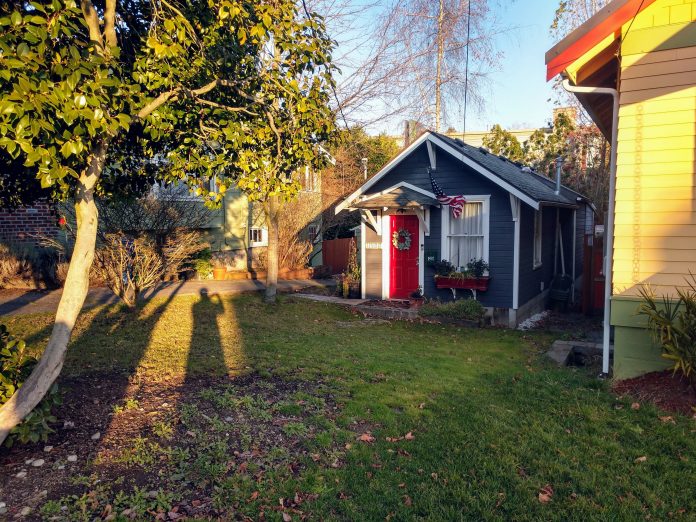
On Monday, the Burien City Council approved a slate of accessory dwelling unit (ADU) reforms. The reforms should make it easier to build ADUs such as backyard cottages and basement apartments in single-family areas and encourage more property owners to invest in them. The city also moved to prohibit the construction of single-family residences in multifamily zones, citing community objectives for greater infill development in those zones.
While Burien is a suburban jurisdiction, it has a growing city center and access to many regional job centers and amenities. Several major bus lines run through the city, including the RapidRide F Line and Routes 120 and 560. The city is also a few miles away from Link light rail and will soon benefit from upgrades of Route 120 to the RapidRide H Line.
In justifying the ADU regulatory reform, a city staff report stated that housing costs were a significant factor. “Housing affordability is one of the greatest challenges facing communities in the Puget Sound region and across the country,” the staff report noted. “Rising demand outpaces the supply of additional housing units, driving prices steeply upward.” According to the report, the city’s planning commission “evaluated policies relating to housing diversity and accessory dwelling units, and incorporated policies that would set the stage for further discussion of middle income housing” during last year’s Comprehensive Plan amendment process.

The regulatory reform includes a handful of changes to ADUs:
- Each lot with a single-family residence will be entitled up to two ADUs. One ADU may be attached or internal to the single-family residence and one ADU may be detached.
- Owner-occupancy requirements will no longer apply. This functionally will allow a property owner to own a single-family residence and one or two ADUs without having to reside on the property.
- Parking requirements will be partially curtailed. Existing regulations require one parking space per ADU, but will not be required when a lot is located within a quarter-mile of a transit stop. Much of the city is located within a quarter-mile of transit stops. The exception will operate on a trial basis for three years.
- Restrictions on the number and location of entryways will not apply, but other development and design standards will still regulate building form and aesthetic considerations.
What does not change is allowed ADU sizes. Generally, attached and internal ADUs are limited to 1,000 square feet while detached ADUs are limited to 800 square feet.

As part of the same ordinance, single-family residences will no longer be permitted in multifamily residential (RM) zones. The city’s planning commission recommended the regulatory change to preserve the limited multifamily zones that exist for higher intensity uses, make better of use supporting services, and help achieve the city’s growth targets.
“Allowing single-family detached land uses in multi-family zones limits the City’s potential to accommodate additional growth and opportunities for housing–both market rate and affordable housing–resulting in lower density development in areas most suitable for additional development,” the staff report states. “As a result, lots in portions of the City are not developed to their zoned capacity, leaving fewer properties available for development, and reducing the likelihood that the City achieves its growth targets. Further, the City does not currently have minimum density standards to ensure that a minimum development density is achieved in each zone.”
Before taking a final vote on the legislation, there was debate over several amendments. One amendment sought by Deputy Mayor Austin Bell–a city councilmember–would have removed the sunset clause on the parking exemption; that amendment failed. Another amendment proposed by Councilmember Lucy Krakowiak would have maintained the owner-occupancy requirement. Both Deputy Mayor Bell and Councilmember Krystal Marx expressed opposition to the amendment on the basis of the prejudicial and inequitable nature of such a policy. That amendment failed, too.
Deputy Mayor Bell spent a considerable amount of time discussing the importance of ADU reform, saying that it “gives us a potential to infill, to gently infill organically in areas where people want to can build a mother-in-law, an additional dwelling unit in a backyard cottage in a way that is often not even visible to the surrounding areas.” He also said it was one way that the city could partially do its part to address the housing crisis and create room for more affordable housing. On a four-to-two vote, the legislation passed.
Separately, the city council took action to approve updates to the Comprehensive Plan, which redesignated several parcels from Community Commercial to High Density Multifamily in the Urban Center, adopted new policies for Burien Urban Center, and other minor technical updates.
Like Tacoma, Burien plans to work on a housing action plan over the next few years. The city received a grant as part of the housing options incentive bill passed by the state legislature earlier this year. The house action plan will be done in conjunction with several neighboring cities, including Kent, Auburn, Burien, Tukwila, Federal Way, and Renton. This ultimately could further assist in the city realizing its goals for more affordable housing options.
Stephen is a professional urban planner in Puget Sound with a passion for sustainable, livable, and diverse cities. He is especially interested in how policies, regulations, and programs can promote positive outcomes for communities. With stints in great cities like Bellingham and Cork, Stephen currently lives in Seattle. He primarily covers land use and transportation issues and has been with The Urbanist since 2014.


